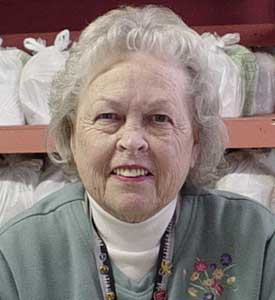-
- Lesbian couple wins custody battle
- S.D. high school approves gay/straight support group
- Pa. Senate hopeful embraces same-sex marriage
- Assembly fails to override veto of marriage bill
- Mass. gay-marriage ban unconstitutional
- Bishop defends distribution of pamphlet condemning same-sex marriage
- Philadelphia wants you
- Student evicted for alleged ‘gay-bashing’ quits school
- National News Briefs
- World News Briefs
san diego
Being Alive affected by closure of area food banks
With government-funded vouchers cut, program sees surge in demand
Published Thursday, 20-Nov-2003 in issue 830
With the recent closure of three San Diego area food banks, Being Alive San Diego has had to stretch their available resources to provide for the needs of the HIV/AIDS community left without food and commodities to supplement monthly household needs.
Other local meal delivery services, such as Special Delivery, which does not rely on food banks for their supplies, have not been affected by the closures. Ruth Henricks, executive director of Special Delivery, said they have actually had an increase in donations since the closures, particularly after the San Diego wildfires. “We’ve actually, at times, had so much food that we’ve had to pass it along [to other agencies],” she said.
However, for those agencies that depended on funding and donations from the government, the closures have been stressful. The Share program, which shut down, literally, overnight, was heavily utilized by many of Being Alive’s clients. With its closure, many clients had to rely on Being Alive’s commodities program instead. Being Alive purchased Share’s remaining vouchers to help supplement their clients’ monthly food intake and to help HIV-positive households unable to make ends meet, but Being Alive was forced to cut their own voucher program shortly afterwards due to the same lack of funding.
“We are dismayed by the lack of food resources currently available to our clients and are seeking ways to increase what Being Alive can offer them each month,” said Shannon Wagner, executive director of Being Alive San Diego.
Eleanor Gaddy, who helps run and organize the monthly food disbursement at Being Alive, has been a volunteer since 1996. A little over five years ago, when Being Alive decided to offer a voucher and commodities program in addition to the other services they offer to the HIV/AIDS community, Gaddy joined forces with Harrison McCall, a Being Alive staff member who works with the Helping Hands moving crew, and a few others to organize the program. In the first few years, the commodities program was run at the same time that Being Alive distributed vouchers to their clients — the first two weeks of every month.
In order to receive Being Alive’s services, clients must be diagnosed with HIV or AIDS. In addition to the commodities, Being Alive’s voucher program purchased vouchers from Vons, Ralph’s, Food 4 Less and other area stores and distributed them each month — $40 a month for each recipient. Since then, Being Alive has had to cut the voucher program due to lack of the same funding that closed other local food banks entirely. The voucher program was discontinued before the grocery strikes.
With the voucher program gone, food bank distribution dropped by over two-thirds. Many clients thought that the commodities program disappeared with the vouchers, even though staff and volunteers tried to spread the word during the remaining months of the voucher program.
“But we’re starting, in the past few months, to gain back some of the people who didn’t realize that just because vouchers weren’t going to be here doesn’t mean that Being Alive isn’t going to be here,” Gaddy said.
The commodities are not taken for granted, either. According to Gaddy, 100 percent of Being Alive’s commodities recipients do not have much income, and what Being Alive can offer them is still not enough. Many families need items such as infant formula, diapers and other childcare products.
There is also a substantial need for pet food and pet care products. For many individuals and families in the HIV/AIDS community, pets are a major source of company, comfort and support. To those already strapped for cash, pet food is a luxury item.
This time of year, donations of holiday items are always welcome too because they are another morale boost for the clients.
For the past four years, members of Mt. Carmel High School’s Key Club have held a holiday food drive for Being Alive.
Last year’s food drive at Mt. Carmel “was absolutely amazing”, recalled Gaddy. “They collected the food before Thanksgiving and we had food that lasted us — you know, we’d only give out a couple of items to [each person] — we had enough for about three months, and it was great.”
Mt. Carmel High is planning another food drive this year. It is already too late for distribution of commodities in time for Thanksgiving, but Christmas will be better because of the extra food.
With Being Alive’s limited time, funding and volunteer resources, however, there are no regular food drives scheduled beyond Mt. Carmel’s once-a-year drive, a situation Gaddy would like to see change.
“Every three months or so, [we’d like to] have a big food drive.”
Donations may be made to Being Alive San Diego and Being Alive North County at any time during normal business hours. For further information about volunteering or donating items, call (619) 291-1400.
|
|
Copyright © 2003-2025 Uptown Publications


